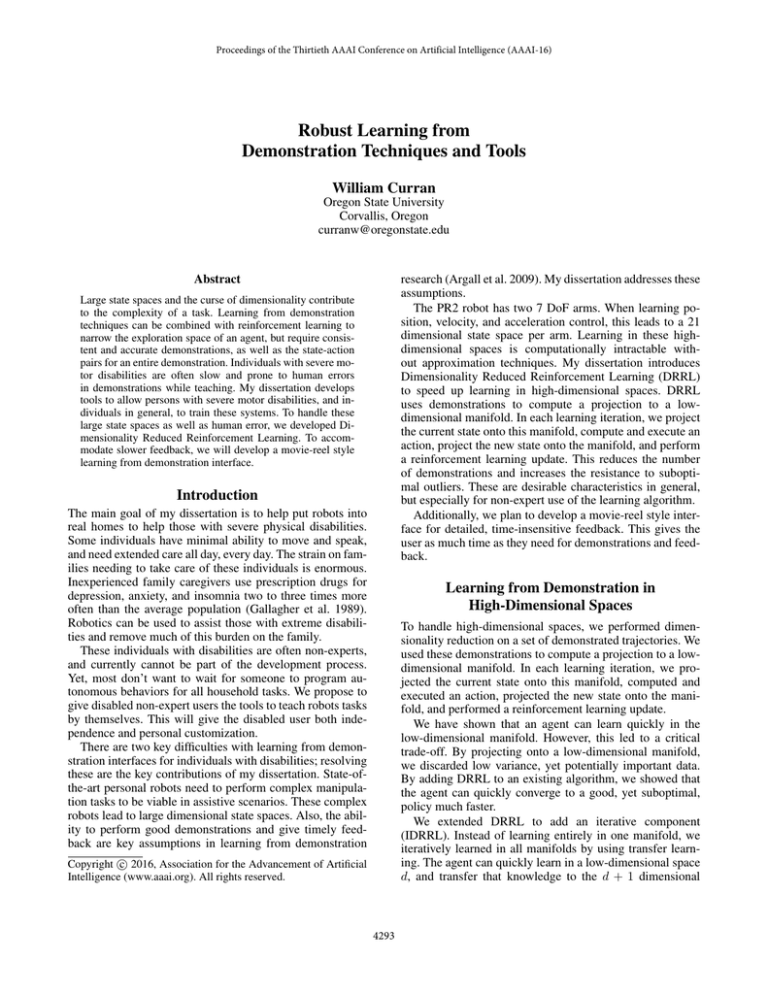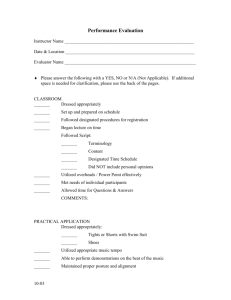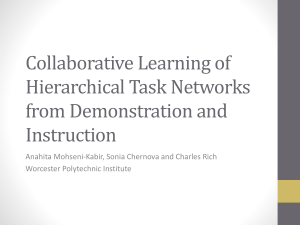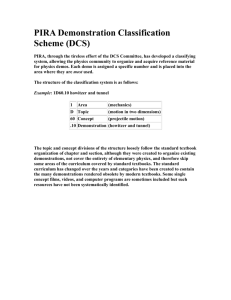
Proceedings of the Thirtieth AAAI Conference on Artificial Intelligence (AAAI-16)
Robust Learning from
Demonstration Techniques and Tools
William Curran
Oregon State University
Corvallis, Oregon
curranw@oregonstate.edu
research (Argall et al. 2009). My dissertation addresses these
assumptions.
The PR2 robot has two 7 DoF arms. When learning position, velocity, and acceleration control, this leads to a 21
dimensional state space per arm. Learning in these highdimensional spaces is computationally intractable without approximation techniques. My dissertation introduces
Dimensionality Reduced Reinforcement Learning (DRRL)
to speed up learning in high-dimensional spaces. DRRL
uses demonstrations to compute a projection to a lowdimensional manifold. In each learning iteration, we project
the current state onto this manifold, compute and execute an
action, project the new state onto the manifold, and perform
a reinforcement learning update. This reduces the number
of demonstrations and increases the resistance to suboptimal outliers. These are desirable characteristics in general,
but especially for non-expert use of the learning algorithm.
Additionally, we plan to develop a movie-reel style interface for detailed, time-insensitive feedback. This gives the
user as much time as they need for demonstrations and feedback.
Abstract
Large state spaces and the curse of dimensionality contribute
to the complexity of a task. Learning from demonstration
techniques can be combined with reinforcement learning to
narrow the exploration space of an agent, but require consistent and accurate demonstrations, as well as the state-action
pairs for an entire demonstration. Individuals with severe motor disabilities are often slow and prone to human errors
in demonstrations while teaching. My dissertation develops
tools to allow persons with severe motor disabilities, and individuals in general, to train these systems. To handle these
large state spaces as well as human error, we developed Dimensionality Reduced Reinforcement Learning. To accommodate slower feedback, we will develop a movie-reel style
learning from demonstration interface.
Introduction
The main goal of my dissertation is to help put robots into
real homes to help those with severe physical disabilities.
Some individuals have minimal ability to move and speak,
and need extended care all day, every day. The strain on families needing to take care of these individuals is enormous.
Inexperienced family caregivers use prescription drugs for
depression, anxiety, and insomnia two to three times more
often than the average population (Gallagher et al. 1989).
Robotics can be used to assist those with extreme disabilities and remove much of this burden on the family.
These individuals with disabilities are often non-experts,
and currently cannot be part of the development process.
Yet, most don’t want to wait for someone to program autonomous behaviors for all household tasks. We propose to
give disabled non-expert users the tools to teach robots tasks
by themselves. This will give the disabled user both independence and personal customization.
There are two key difficulties with learning from demonstration interfaces for individuals with disabilities; resolving
these are the key contributions of my dissertation. State-ofthe-art personal robots need to perform complex manipulation tasks to be viable in assistive scenarios. These complex
robots lead to large dimensional state spaces. Also, the ability to perform good demonstrations and give timely feedback are key assumptions in learning from demonstration
Learning from Demonstration in
High-Dimensional Spaces
To handle high-dimensional spaces, we performed dimensionality reduction on a set of demonstrated trajectories. We
used these demonstrations to compute a projection to a lowdimensional manifold. In each learning iteration, we projected the current state onto this manifold, computed and
executed an action, projected the new state onto the manifold, and performed a reinforcement learning update.
We have shown that an agent can learn quickly in the
low-dimensional manifold. However, this led to a critical
trade-off. By projecting onto a low-dimensional manifold,
we discarded low variance, yet potentially important data.
By adding DRRL to an existing algorithm, we showed that
the agent can quickly converge to a good, yet suboptimal,
policy much faster.
We extended DRRL to add an iterative component
(IDRRL). Instead of learning entirely in one manifold, we
iteratively learned in all manifolds by using transfer learning. The agent can quickly learn in a low-dimensional space
d, and transfer that knowledge to the d + 1 dimensional
c 2016, Association for the Advancement of Artificial
Copyright Intelligence (www.aaai.org). All rights reserved.
4293
can efficiently teach the robot through demonstration.
The interface for users with disabilities will use a less direct approach. The robot will come with a motion library of
basic autonomous functions, such as turning knobs and picking up objects. First, the user will give the robot a sequence
of these high level actions to perform the task. The robot will
simulate itself doing the task in RViz. We will extend RViz
with a movie-reel style interface for rewinding and fast forwarding of the robot’s simulation. The user can then provide
feedback on an action at his or her own speed. This learning
from demonstration interface allows the users to build custom routines for the robot without direct knowledge of the
reinforcement learning algorithm.
To analyze the initial efficacy of the movie-reel style interface there will be a within-subjects study, in which the users
will be able-bodied. We will take objective measurements
such as the total task time and the user’s cognitive load, as
well as subjective measurements with questionnaires. We
will then perform another study with disabled individuals
that have previously worked with our lab. Comparing the results will give us a better understanding of the efficacy of the
interface.
Figure 1: DRRL and IDRRL were combined with standard
Q-Learning. DRRL converged faster, but to a slightly suboptimal solution. IDRRL converged quickly to an optimal solution. Additionally, IDRRL is robust to suboptimal demonstrations in Mountain Car 3D.
space using the known mapping between the spaces. We
have shown the speed and robustness of this approach when
combined with standard Q-Learning in the Mountaincar 3D
(Figure 1) domain using good and bad demonstrations. Increasing the robustness to human error in demonstrations
and reducing the number of demonstrations are essential.
Since we work with individuals with disabilities, physical
demonstrations are difficult, and expect suboptimal demonstrations. Since demonstrations are difficult, fewer demonstrations are also a desirable quality.
We plan to extend this work to robotic control. By parameterizing the motor primitives in a low-dimensional manifold, we hypothesize that we will be able to more easily
generalize motor skills to similar tasks. This will reduce the
number of different demonstrations required. Additionally,
dimensionality reduction smooths the lower-dimensional
trajectory. We hypothesize that this makes the learning more
robust to suboptimal outliers caused by human error.
Conclusion
Those suffering from ALS and quadriplegia need assistive
robots now. These individuals cannot wait for someone to
program autonomous behaviors for all household tasks. This
work intends to help those suffering from severe physical
disabilities by giving them the ability to teach the robot
themselves.
This work introduces a new learning from demonstration technique that utilizes human demonstration from nonexperts. This requires robots to learn from human demonstrations, even when those demonstrations are suboptimal.
By learning in a lower-dimensional space, we hypothesize
that it will be easier to generalize between similar tasks, as
well as ease the learning of trajectories with outliers.
With these new interfaces and learning advances, individuals with disabilities will be able to do day-to-day tasks
without help from others. The lack of a human assistant performing the task and the addition of positive experiences like
teaching, doing it yourself, and being more independent increases the quality of life for people with extreme disabilities.
Learning from Demonstration Interfaces
We need to develop a learning from demonstration interface
that allows individuals with disabilities to teach their assistive robot at their own speed. We propose two interfaces: an
early interface for super users, and one for users with severe physical disabilities. In this work we will use RViz, a
ROS package that assists users in the visualization of robotic
movements and sensors (Quigley et al. 2009). Our first focus
of research is to extend RViz to be an interface for learning
from demonstration.
The interface for users without disabilities will take advantage of the direct first-person control aspect of RViz. We
will also use the Oculus Rift and Razer Hydra control systems. The Oculus Rift allows a user to see through the sensors of the robot, while the Hydra controls the robot. The
Hydra control system computes the exact location and orientation of controllers in your hands, allowing the user more
natural control of the robotic arms. Using these tools the user
References
Argall, B. D.; Chernova, S.; Veloso, M.; and Browning,
B. 2009. A survey of robot learning from demonstration.
Robot. Auton. Syst. 57(5):469–483.
Gallagher, D.; Rose, J.; Rivera, P.; Lovett, S.; and Thompson, L. W. 1989. Prevalence of depression in family caregivers. The Gerontologist 29(4):449–456.
Quigley, M.; Conley, K.; Gerkey, B. P.; Faust, J.; Foote, T.;
Leibs, J.; Wheeler, R.; and Ng, A. Y. 2009. ROS: An opensource robot operating system. In ICRA Workshop on Open
Source Software.
4294




